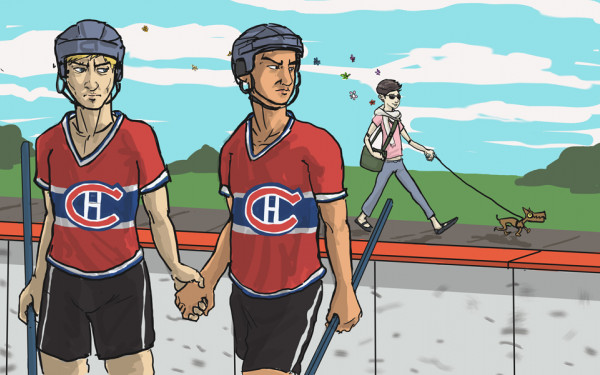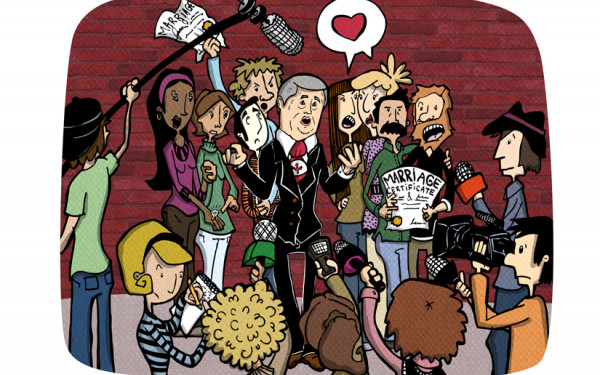Out in the Locker Room
Young Gay Athletes Face a Sports Culture in Flux
Although there are gay politicians, entertainers and writers, there are few gay athletes—especially male ones.
In the four largest sports leagues in North America—the National Hockey League, National Football League, Major League Baseball and National Basketball Association—there still hasn’t been one male athlete to come out while active.
Sports, especially men’s sports, continue to be one of the last places in society where it seems being gay just isn’t accepted.
Nevertheless, numerous Concordia Stingers athletes, both male and female, say that they would be comfortable having a gay teammate. But despite consciously accepting different sexual orientations, locker room culture might be causing problems.
The two Stingers captains interviewed both recognized that they may have had gay teammates at some point in their lives, but doubt they have any gay teammates now.
“I would have no problem [with having a gay teammate]. I don’t see how it would affect the game or the player,” said Dario Pellizzari, captain of Concordia’s men’s rugby team.
Taylor Garner, captain of the men’s basketball team, agreed.
“Personally, it’s not an issue to me at all,” Garner said. “Sexual orientation holds no bearing to me. I’m not one to judge anyone for who they are. It really makes no difference to me if I had a gay teammate or not.”
Although they did not want to speak for their teammates, Garner and Pellizzari both expected that if a teammate were to come out, he would be treated with respect.
Nevertheless, the sports world still seems intimidating for gay athletes. One of the main reasons could be the prevalence of a subtle form of homophobia that surfaces in homophobic language, which those interviewed said was common in the locker room.
In the sports world, casually tossing the word “gay” around or calling someone a “faggot” is commonplace. Despite the players’ openness and potential acceptance, the continued use of this language makes these barriers much harder to break down.
“I’m sure it would affect the person if it was used,” said Pellizzari. “But it’s almost second nature to us now. We don’t even think about it, you know? When we say it it’s just an expression.
“Should it be monitored? Probably.”
“[For] someone who was gay to have to listen to that, I think would kind of regress them in their process of coming out, if they wanted to,” said Garner.
Galen Dodd, a high school volleyball player in Los Angeles who told his story to outsports.com, said that this typical language did impact him.
“Every practice I would hear some sort of comment about something or someone being ‘gay’ or a ‘fag,’ and each time I cringed thinking of how I would never be able to be who I truly am with them,” Dodd said.
“Even though those terms are not meant to be harmful, and don’t even seem relevant to what the speaker is trying to express, it has become common language among teenagers and young adults. But after I came out, my fellow players have been nothing but supportive.”
While the men’s teams might be comfortable with a gay teammate in the locker room, for one of Concordia’s women’s teams, the issue has already been resolved.
Goalkeeper Saby Dagenais, who is in her second year of playing on Concordia’s women’s soccer team, came out soon after joining the squad.
“I did not even hesitate whether to say it or not to say it,” Dagenais said. “It just came out with me naturally and I was really open about it. I was very accepted for that.”
But Dagenais’s situation seems less likely in men’s sports. According to the athletes, society continues to expect male athletes to be very masculine, making it more difficult for anyone who doesn’t fit the typical macho mould.
“Qualities required in a sport for guys are the classical qualities of a typical masculine guy,” said Dagenais.
“To be an athlete, it’s more of a macho, manly sort of profession,” Garner agreed. “Professional athletes are sort of the epitome of all things masculine.”
Although things definitely need to change, as our society needs to change its conceptions of the typical athlete, and athletes need to gain a better understanding of the harmful effects of homophobic language, the athletes interviewed were optimistic that more gay athletes will begin to come out in the future.
“So hopefully, as we become more and more comfortable with this [idea], gay players will feel more comfortable being able to come out. It’ll take a little bit of time for sure, but hopefully it’s the way society’s going right now,” Garner said.
Considering the male athletes who have come out, such as former Montreal Impact soccer player David Testo, former NFL player Wade Davis, and boxer Orlando Cruz, who is still active, it looks like the future could be positive.
Given the way Garner and Pellizzari both said they would react positively to having a gay teammate, it’s possible something similar would happen on a Concordia men’s sports team.
Nevertheless, even if they haven’t had any out teammates, the prevalence of homophobic language in our culture and in our locker rooms is going to continue to keep people in the closet.
Increased awareness of the negative effects of homophobic slurs, even if not used menacingly, and a growing acceptance that gay men can compete in “macho” sports, such as Davis did in football, could open up doors for more athletes to come out.
Although homophobia seems to be slowly dissipating, lots of work still needs to be done. An increased awareness about the harmful effects of homophobic language could go a long way in making the sports world more welcoming for gay athletes.
But as more and more professional athletes come out after their retirement, and more and more amateur teams come to terms with having gay teammates, it’s possible that, some day in the not-too-distant future, gay athletes will be judged by their play, not their orientation.

_900_524_90.jpg)
_600_832_s.png)



ED1(WEB)_1_600_375_90_s_c1.jpg)
(WEB)_600_375_90_s_c1.jpg)